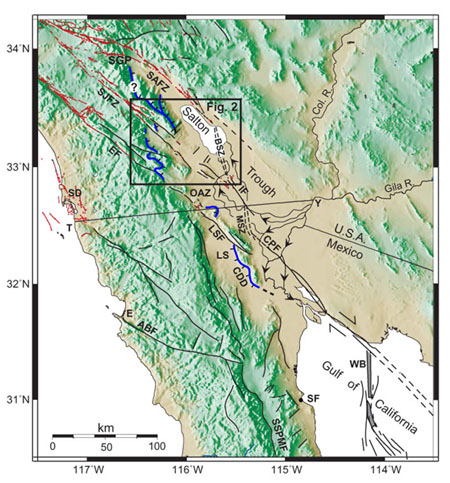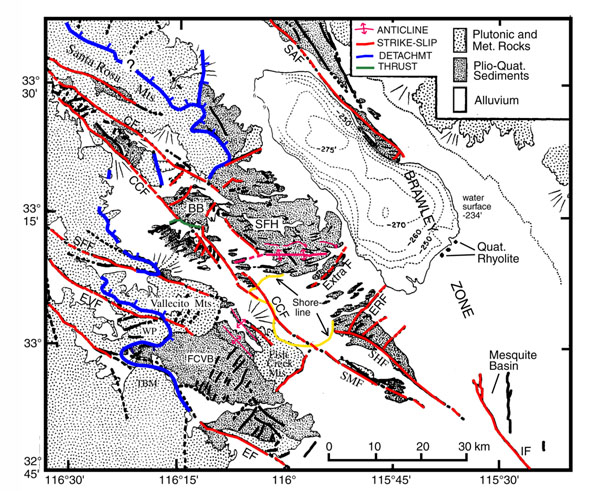
Figure 1. Regional topography and faults
This is an NSF-funded study of Late Cenozoic detachment faulting and its controls on basin formation and sedimentation in the western Salton Trough of southern California (see figures below). I am collaborating with three other P.I.s on this project: Susanne Janecke at Utah State University, Gary Axen at UCLA, and Bernie Housen at Western Washington University. Our study is motivated by the discovery by Axen and Fletcher (1998) that a system of low angle normal faults in the wesern Salton Trough was active from Late Miocene to early Pleistocene time. We are working to refine our understanding of the timing and kinematics of detachment fault slip, the resulting basin architecture and sedimentation patterns associated with this fault system, and relationship of the faults and basins to co-eval slip on the San Andreas fault. Graduate students Andy Lutz (UO), Stefan Kirby (USU), Alex Steely (USU), Mary Kairouz (UCLA), and Amy Fluette (WWU) are presently working on this project.

Figure 1. Regional topography and faults

Figure 2. Simplified geologic map.
Below is a brief summary of some preliminary findings.
The presence of the west Salton detachment (low-angle normal fault) system has been tested and verified, basically as proposed by Axen and Fletcher (1998) except that several strands of the detachment system confined within basement rocks are late Cretaceous, amphibolite(?)-grade reverse-sense brittle-ductile shear zones. Locally, these shear zones were followed and reactivated by normal-sense brittle fault strands of the detachment system. Others may be late Cretaceous(?) normal-sense faults zones, as originally interpreted by George and Dokka (1994). Late Cenozoic upper-plate transport toward the northeast to east was at least partly coeval with dextral slip on the San Andreas fault, and created two large sedimentary sub-basins that filled with the Imperial, Palm Spring, Canebrake, and other related sedimentary formations in the western Salton Trough.
A well-exposed fault on the northeast margin of the Tierra Blanca Mts. that formerly was considered to be a strand of the Elsinore fault is now recognized as a large normal fault that makes up part of the break-away zone of the detachment fault system. Geomorphic evidence shows that the frontal fault of the Tierra Blanca Mts. has been active in late Quaternary time and represents either continued slip or reactivation of the detachment fault in the present strike-slip regime. Structural and paleomagnetic data show that most strands of the detachment fault system have been cut, deactivated (locally reactivated), and folded by the modern system of strike-slip faults and related folds of the San Jacinto and Elsinore fault zones. Active strike-slip deformation has heavily overprinted and disrupted the extensional detachment fault and its supradetachment basin, obscuring their expression in many places. Thus the timing and significance of the west Salton detachment fault system are only now beginning to be fully understood through this new work.
There are two main sub-basins associated with the detachment fault that differ markedly in their stratigraphic architecture and evolution: the well studied Fish Creek-Vallecito basin in the south, and the relatively poorly understood Borrego - San Felipe basin in the north. Preliminary work shows that facies in the Palm Spring, Canebrake, and Borrego Formations differ greatly between the sub-basins and even within individual subbasins. Future work will characterize the nature of these differences and their significance for basin evolution. A widespread unconformity in the southern San Felipe Hills records broad uplift, erosion, and gentle tilting prior to deposition of the laterally equivalent Ocotillo and Brawley Formations. Most tight folds and faults associated with the modern San Jacinto fault zone deform and post-date the Ocotillo and Brawley Formations, indicating that the active system of strike-slip-related transpression is very young, post-1.0 Ma. Influx of the Ocotillo Formation beginning at about 1.2 Ma probably was fault-controlled, and is inferred to be related to either initiation or reoranization of the San Jacinto fault zone.
Return to Dorsey's Homepage
This page was last updated October 2003, by Becky Dorsey.